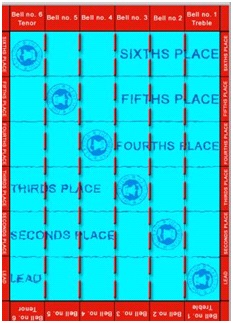Elementary … Practices for Module 2
At Rattlesden, Suffolk, ART Assessor Pam Ebsworth had a number of teachers who hadrecently attended an ART Module 2 Day Course - Teaching Elementary Change Ringing. Pam was wondering how to give her teachers more teaching practice. The problem was that these particular teachers were not Tower Captains and were finding difficulty getting opportunities to teach at the necessary level. After discussion with other mentors it was decided to hold a dedicated Learning the Ropes Level 2 practice. In line with the Level 2 syllabus, this practice would concentrate on Foundation Skills and ringing with others. A date was fixed during July and the day attended by three mentors, five teachers and various new ringers.
The topics to be covered were:
- Controlling the bell
- Listening to the strike of the bell
- Following different bells when changing places
- Understanding the concept of place in the row
- Calling the bells to stand
- Understanding the concept of place in the row
- Starting to give simple instructions
Each teacher was to teach the new ringers one of these topics following discussion with the mentors. Obviously there are many different ways these various things can be introduced but these are the methods used by the Suffolk teachers.
Controlling the bell
Teacher number one used ‘whole pull and hold on the balance’. She taught when to pull off visually and how to listen for the strike of the bell. This is an excellent introduction to leading skills. The new ringers picked it up very quickly!
Listening to the strike of the bell
‘Ringing blind’ in rounds was used to help with listening skills. After learning to turn around while ringing, each ringer did this in rounds until the whole band was ringing ‘blind’. The task was taken to a more challenging level when Call Changes were added!
Following different bells when changing places
Teacher number three explained the theory of Call Changes, how adjacent bells change places and explained that bells can be called by the ‘up’ or ‘down’ method. He used numbered door knobs to explain this theory. Practice was then given using individual Call Change activities using the least preferred calling method! It’s good to be put out of your comfort zone.
Developing a sense of place in the row
The fourth teacher explained the concept of calling changes by calling by place in the row rather than by the number of the bell. Interestingly enough this proved quite straightforward for the new ringers and they took to it more easily than some established ringers do. It is important for ringers to start to be aware of their place in the row from early in their ringing career as without this awareness moving on successfully to method ringing will be more difficult.
The teacher also taught the ringers how to move out of the way and back again while the treble moved up to 5ths place and back down again. Apart from learning the speed changes without worrying about which bell to follow, this is very useful for teaching ‘place’ as the treble follows the 2 in 2nds place, the 3 in 3rds place etc. It also challenges the ropesight of the other ringers!
Another teacher had the ringers walking Plain Hunt on three bells down the church aisle. The person/bell moving down stepped in front of the person/bell moving up. This covered what most of us would consider to be fairly advanced theory but yet again the new ringers soon grasped the idea.
Starting to give simple instructions
The fifth teacher explained to the new ringers that ringing instructions are generally made when the treble handstroke is just starting. The action then takes place at the following handstroke. He explained that the call needs to be loud enough for everyone to hear. The new ringers practised calling ‘stand’ from rounds and achieved this very quickly.
The Results
The practice turned out to be a very interesting and challenging session. It certainly made all the teachers and mentors change their ideas about how much information relatively new ringers can absorb when concepts and activities are presented in an interesting and different way. Although the practice session was primarily designed for the teachers to hone their teaching skills, a lot of learning took place by the new ringers even though the bells were actually rung for less than half of the time.

For a useful visual aid to explaining call changes, the Whiting Society have come up with an excellent aid in the form of a pictorial representation of a swimming pool divided into lanes. Each lane represents one bell but for example bell 3 may be well out in front and leading while bell 4 may be in 5ths place.
Pip Penney